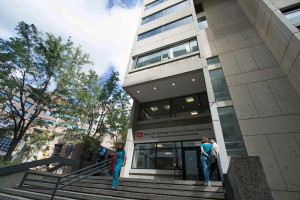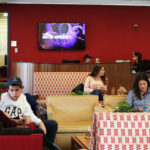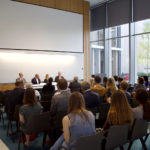
In a partnership with Sirona Dental Systems, Inc., Dean Jeffrey Hutter of Boston University’s Henry M. Goldman School of Dental Medicine announced the creation of a digital campus for the school Friday, the first of its type in the nation.
Sirona is a dental company that provides multiple product lines for dentists worldwide. The partnership with BU will provide access to online resources usable for dental students.
Betsy Ashworth, a sales manager for Sirona who worked closely with the project, said the partnership will benefit students, staff, faculty and patients.
“This is the first school in the nation to go to this extent to create this digital atmosphere,” she said. “It allows technology to be available to all departments, all faculty members and all patients.”
Ashworth said she was excited to bring about a new wave of technology to students at SDM.
“The digital dentistry platform that is under way allows all students the opportunity to work with types of digital technologies,” she said.
Sirona’s partnership will grant SDM students easy online access to Sirona’s CEREC, Schick, GALILEOS and inLab products, allowing for the curriculum to embrace modern technology in the classroom.
CEREC, the main addition to the school’s digital campus, will provide better learning for students and easier treatments for patients, Ashworth said.
“[CEREC] is something that has been around for 30 years. Now, its student doctors will be able to provide restoration treatment in a single appointment,” she said. “They are also using a new software to learn preparation for the real world dental industry.”
Louis Brown, a professor at SDM, said he remains confident that this digital approach will not take away from traditional learning.
“There are always concerns every time you change the curriculum. But most of the faculty, rather than feeling concerned, are much more excited. Everyone knows this is where the future lies,” he said.
Despite the digital push, Brown said the school would always be a traditional classroom.
“Classroom teaching is a part of what we do. What ends up happening is obviously you have to do the book learning,” he said. “The transition we’re going through now has to do with how we’re making [dental] impressions. A lot of what we do starts to exist with virtual models.”
Many students described the transitional period as being simple despite the new technologies that they are tasked with using.
Divya Swarup, a second-year student in SDM, said she was not worried that new dental technology would replace existing methods entirely.
“They haven’t completely stopped [traditional teaching],” she said. “If I’m working on a patient, instead of putting any material in their mouth, now there is just a wand-like device, and we can just take pictures. It eliminates the use of impression materials; but we do cases with both traditional impressions and digital impressions.”
Caroline Michaels, a first-year student at SDM, said she is confident BU would provide a smooth transition for adopting the new technologies.
“BU does a pretty good job of helping us along with helping us feel comfortable with new technology,” she said. “This is going to be the same. They’ll help us translate what we’ve learned compared to the older methods.”
Swarup said the technologies make the learning process more efficient.
“They are faster, we learn better and it visually shows us the things we are learning,” she said. “Everything is standardized… It’s more exact, and it eliminates human error.”
Michaels said the digital campus is necessary to adapt to the technological advancements.
“Technology is not going away, and it’s not going anywhere anytime soon,” she said. “These machines are already being used in a lot of different practices around the country. They are beneficial to both the patient and the practitioner.”





It’s a good move!